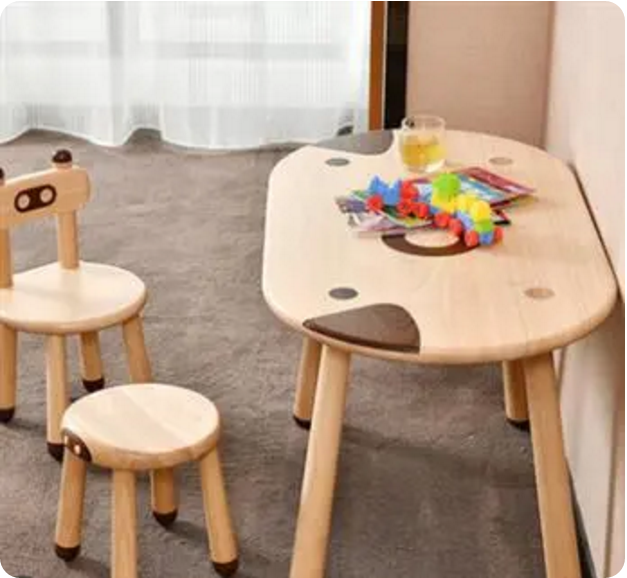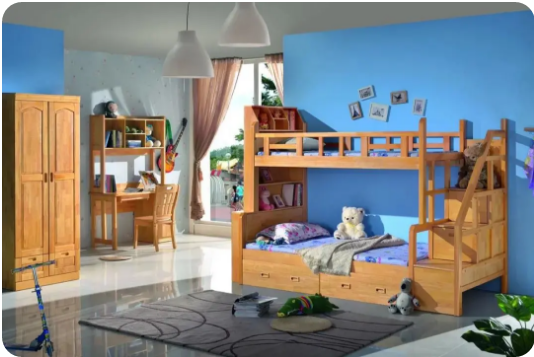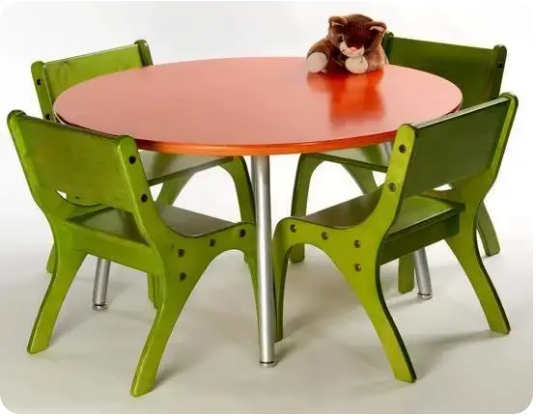↓

What are the possible safety hazards of defective children's furniture?
1. Excessive harmful substances in furniture can cause chemical pollution damage
Unlike adults, children are more sensitive to chemical substances in the environment, and the harmful substances in furniture exceed the standard, which will cause great harm to children's physical and mental health. So, what are the "culprits" in these children's furniture? Common ones include formaldehyde, migratable elements (antimony, arsenic, lead, etc.), phthalates, etc. These are also included in the "General Technical Conditions for Children's Furniture" implemented on August 1, 2012. Provisions.
2. The furniture may cause personal injury when used due to improper design or production
(1) If the furniture is not fixed properly, it may tilt and fall over and overwhelm children
If children's bookcases and wardrobes are higher than 600mm but are not equipped with connectors that are fixed on the wall, children may overturn the cabinets and press themselves when climbing, which may lead to child deaths in serious cases.
(2) The furniture has sharp edges or points, which may cause knocks and bruises to children
Parents know that children will inevitably bump into each other when they are playing. If the corners and edges of the children's furniture are not rounded, it will easily cause bumps and bruises, which will cause harm to the children.
(3) The furniture has holes or gaps, and children may have crush injuries if they put their fingers in
Some children's furniture has holes or gaps. Children are often curious and will stick their fingers in, which may get stuck. Therefore, the diameter or gap of the holes or gaps of children's furniture products should be less than 6mm or ≥12mm.
(4) Confined damage
In order to prevent children from hiding in cabinet furniture for too long and suffocation, the cabinet type closed furniture used by children should have a certain ventilation function.
(5) Entangling damage
Children are curious about things like ropes, and they may become entangled when they are playing. Once they are restrained, they cannot break free themselves. It is easy to cause ischemia and necrosis, and even life-threatening in severe cases. Therefore, the length of the ropes, ribbons or tying ropes on children's furniture should not be greater than 220mm.

What are the precautions when purchasing children's furniture?
1. Don't buy "three noes" products
Parents should pay attention to whether the product has a quality inspection certificate, the name and address of the manufacturer, and the product standard number implemented by the product when purchasing. Products without the above information are generally manufactured by informal manufacturers, and quality and safety are not guaranteed. There may be a safety hazard.
2. When buying children's furniture, pay attention to environmental protection and harmlessness
When choosing children's furniture, parents must ask the merchant to issue the furniture factory inspection report and environmental protection certificate to check whether the content of harmful substances such as formaldehyde and heavy metals exceeds the standard. If the merchant cannot provide the inspection report, it is recommended not to buy it.
3. Don't choose overly gorgeous children's furniture
If the color of the furniture is too bright, the lead content in the paint may be higher, and the possibility of heavy metal poisoning in children may be higher.
4. Don't buy furniture with sharp edges and sharp edges
The corners and edges of children's furniture should be rounded, especially desks, cabinet edges and other furniture should not have sharp corners to avoid children's knocks and bumps.
5. Do not buy furniture made of materials with a higher risk factor
For example, it is not advisable to use fragile materials such as glass and mirrors as panel materials for cabinets. Metal objects such as rivets and other fixed furniture should not be exposed to prevent children from being injured during play.
6. The purchased children's furniture is higher than 600mm, and the merchant is required to provide connectors to fix the furniture on the wall to prevent the furniture from falling over and hurting children.
7. When purchasing furniture, merchants are required to provide invoices or other shopping vouchers as important vouchers for future rights protection.

Tips
If children's furniture is found to have the above safety hazards in daily life, you should not buy it. If you have already purchased it, you should take timely measures to eliminate safety hazards: first, contact the business; second, seek the help of relevant departments to actively protect rights.
Add.:Room703、705/7F, Development Building, Tian An Hi-Teck Ecological Park, No.555 North Road Panyu Avenue, Panyu District, Guangzhou City, 511400, China
Tel.:020-39211670 Fax:020-39211640 E-mail:info@certitek.cn

